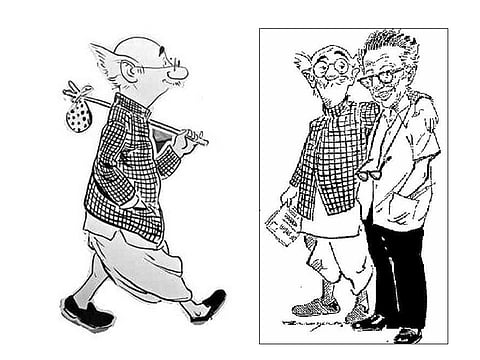RK Laxman and his indelible brushstrokes on the Indian mindscape
By Swarnima Bhattacharya
In a glowing tribute to R.K Laxman, India's foremost cartoonist, humorist and political satirist (to say the least), The Times of India called him the "uncrowned conscience keeper of the nation".
I remember encountering the magical and pithy effects of Laxman's deft brush-strokes, even before I knew that a nation and its makers needed conscience-keeping. In a middle-class, upwardly mobile family like ours, the daily news from The Times of India furnished not only our dinner-time conversations, but was also the repository of what my teachers fondly called "general knowledge".
Adding immensely to that body of knowledge, introducing layers of pointed, good-humoured criticism to prevalent discourse, were the inimitable cartoons of RK Laxman.
The nameless Common Man, the ubiquitous, immediately recognisable old man, dons the attire of our grandfathers. The checked coat is a vestige of colonial legacy, and the dhoti, harkening back to a more Indian sartorial legacy.
He also wears an unchanging wry, bemused expression, similar to what I have often imagined on my father's face, after a long day in a battered government office, or standing in a long queue outside the electricity office.
As I grew up, I didn't need telling to make me know that the endearing Common Man was us-not one of us- but the essence of all of us consolidated on canvas. In an interview with Karan Thapar, RK Laxman recalled how the discovery of the iconic Common Man was rather an accident.
Overwhelmed by the sheer plurality of Indian identities, Laxman started off by drawing representatives of multiple religious and cultural denominations as mute spectators to national goings-on. The Common Man, as we now know him, emerged suddenly, mainly as a result of economising time and space.
And now, this prodigious accidental discovery, is an enduring institution unto itself. For over five decades, the Common Man has peered out of the small cartoon corner of The Times of India. He has been a silent, marginal figure who simultaneously occupied the most private spaces of bureaucrats, politicians, prime ministers of the country, presidents of the United States and even the corners of our drawing rooms.
He remained silent and brooding, with an occasional furrowed brow, but largely unfazed. Since 1947, the year of our independence, he documented for more than half a century, our challenges, idiosyncrasies, dogmas, follies and some moments of redemption.
In his own words, RK Laxman outlined the role and responsibility of a political satirist in so many words, "Ceaseless public criticism is the best guarantee that the liberty of the individual as well as of the nation will be preserved".
Truly enough, the joke was on everyone. During the tumultuous years of the Emergency, the rights of the cartoonist were suspended for about 20 months. But soon enough, the tongue-in-cheek satirist hit out with this cartoon.
Prime Minister Jawahar Lal Nehru was a well-known admirer of Laxman's sharp eye and incisive draftsmanship. After finding himself to be an object of ridicule in one of the cartoons, for his role in the Indo-China war, Nehru is said to have requested Laxman for a signed, enlarged and framed copy of the cartoon. Irreverence and dissent had never been more relished and welcome.
Always exposing the avarice of bureaucrats, rapacity of politicians, self-serving deviousness of Ministers and the foibles of everyday people, Laxman never failed to add a dash to humour to commonplace frustrations. It was the quotidian that found centerstage in Laxman's world of inoffensive derision.
Even though the Common Man was tucked up in the margins of the frame, it was his very relatable presence that has been institutionalised in the Indian political imagination. Unlike the screaming, busy-looking debaters that are now found in profusion in mainstream media, Laxman remained an astute political commentator with his dignity and sense of humour intact.
The fact that his mocking eye survived the ire of successive governments, rioters, angry mobs and offended corridors of power, says a lot about his artistic method. He possessed an uncanny ability to cut through the most entangled of national and social problems, and capture the crux of the matter in one raised eyebrow, or a twisted grin, or a swish of the wrist.
His satire didn't need distended vocal chords or reams of paper, but just a few words. He found "reason" in chaotic discourse, as Shakespeare would say, as "two grains of wheat hid in bushels of chaff". The Common Man didn't topple governments, or change policy, or impact development.
Despite that, never has the Common Man, the weary yet optimistic Everyman, been more empowered and entitled than on the canvas of RK Laxman- not even through political parties whose names commemorate the proverbial "aam aadmi". Heralded as the "uncommon" creator of the Common Man, RK Laxman breathed his last on January 26, 2015.
He left behind a glowing legacy of menacing caricatures on power, development, corruption and social inequity. As you stand beside the statues of the Common Man in Pune and Mumbai, you are struck with the realisation, that this is no celebrity, even though he is a celebrated iconoclast.
The Common Man is a poignant reminder of our own exalted and significant, but oft-forgotten position as the largest electorate in the world.


